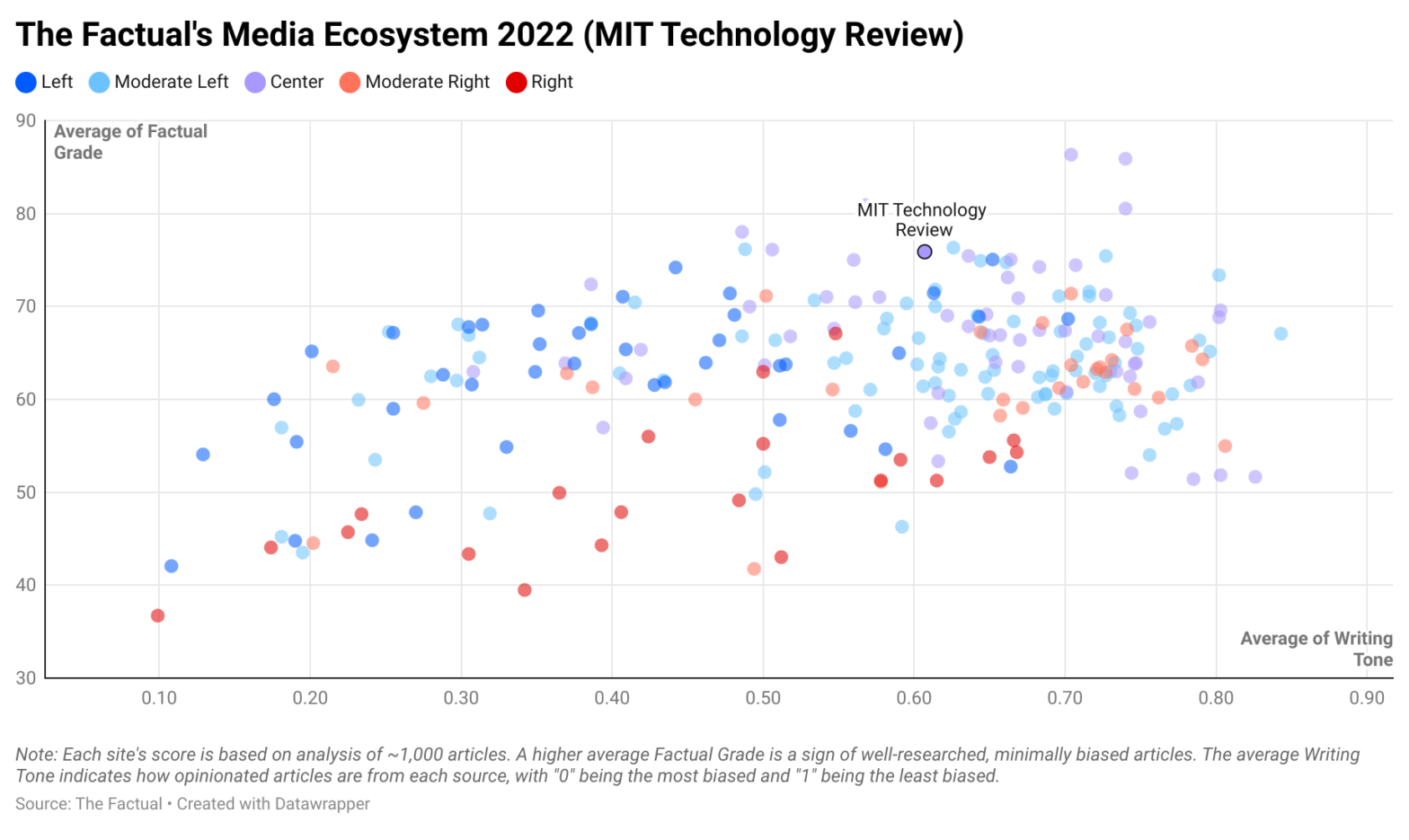MIT Technology Review is a bimonthly science and technology magazine associated with the Massachusetts Institute of Technology, “the world’s foremost technology institution.” The publication is known for its annual series on innovators under 35, the top 10 technology breakthroughs of the year, and the world’s 50 smartest companies. Despite the magazine’s strong background, it’s worth asking: how reliable are articles from MIT Technology Review?
How Does The Factual Rate News Sources?
The Factual analyzes more than 10,000 news stories every day to help readers find the most informative, least-biased articles. Our news-rating algorithm scores each article along four metrics: (1) cited sources and quotes, (2) publication history, (3) writing tone, and (4) author expertise. These scores combine in a weighted average we call a Factual Grade, which ranges from 0–100%. (See our How It Works page to learn more about our algorithm.)
For this study, we analyzed ~1,000 articles each from 240 news sources. The average Factual Grade for the entire dataset was 62.5%. Based on these averages, we can compare the performance of news sites across the media ecosystem. The entire dataset can be explored in greater detail here.
How Factual Is MIT Technology Review?
MIT Technology Review scored an average Factual Grade of 75.9%, placing it in the 96th percentile of our dataset. In fact, the site scored the ninth-highest score of all sites that we analyzed.
The publication’s high average is due to a number of factors. Its articles maintain a rigorous attention to sourcing, always including links to numerous, high-quality external sources. The site relies on highly experienced authors who routinely publish high-scoring articles on the same topics, indicative of high topical expertise. The only factor that detracts from these scores is that articles at times can incorporate opinionated language or headlines.
Like any news source, scores for articles from MIT Technology Review varied widely based on factors like author expertise and cited evidence. For example, some scored above 90%, while others scored below 60%.
Please check your email for instructions to ensure that the newsletter arrives in your inbox tomorrow.
How Opinionated Is MIT Technology Review?
One of the metrics The Factual uses is the Writing Tone, which measures how opinionated the writing is in an article. For this metric, the algorithm looks for signs of subjective commentary (e.g., first person pronouns and unnecessary adverbs), as well as the emotional nature of selected words, and sees how prevalent they are for a given length of text. More neutral text receives higher ratings, with “0” being the most opinionated and “1” being the most neutral.
MIT Technology Review had an average Writing Tone score of 0.61, placing it in the 47th percentile in our dataset for this metric. This suggests that articles from the site tend to have a moderately opinionated writing tone. This can be seen through headlines such as “US emissions plummeted this year, for all the wrong reasons” and “The dangerous appeal of technology-driven futures.”
What Is the MIT Technology Review’s Political Bias?
The Factual classifies news sites by political bias as either Left, Moderate Left, Center, Moderate Right, or Right. This classification comes from third-party assessments from media bias organizations such as AllSides and Media Bias/Fact Check (MBFC). Based on this data, The Factual assigns MIT Technology Review a Center bias. (AllSides has not yet reviewed MIT Technology Review.)
MBFC classifies MIT Technology Review as “Pro-Science,” which it defines as relying on extensive evidence, scientific sourcing of information, and unemotional language. Such sources may at times have a slight political bias, but the site appears largely centrist and science-driven. However, bias has appeared at times, such as in titles like “The Gaping, Dangerous Hole in the Trump Administration.”
The magazine’s editorial guidelines detail its approach:
We don't reflexively give equal weight to all sides of a discussion. In matters of controversy, we will report the arguments of both sides fairly; but our ethical obligation is not to please any interest or party to a debate, but to bear witness to the truth if we know it, or to delineate the terms of the controversy if the truth of the matter is genuinely in doubt.
Who Owns MIT Technology Review?
MIT Technology Review is entirely owned by the Massachusetts Institute of Technology, a highly regarded, privately owned university often recognized among the world’s top academic institutions. Despite the university’s full ownership of the magazine, MIT Technology Review maintains editorial independence:
We benefit from the Institute's many resources, including easy access to its prominent faculty and researchers. At the same time, our coverage of technology is independent of MIT. We do not favor people or technologies simply because they are associated with the Institute.
Please check your email for instructions to ensure that the newsletter arrives in your inbox tomorrow.
Why Does It Matter?
News articles always have some bias because all authors have some frame of reference within which they describe a story. Political bias ratings are helpful in understanding this framing. However, it can be more beneficial to know how factual an article is based on quantifiable metrics that can be seen across the media ecosystem, such as cited evidence, author expertise, and writing tone. This is what The Factual ascertains.
Reading several, highly rated articles from across the political spectrum helps counter the bias of any news source or story. To have the day’s most factual news stories delivered to your inbox every morning, subscribe to our daily newsletter.
Article updated on September 19, 2022 to reflect new data.

